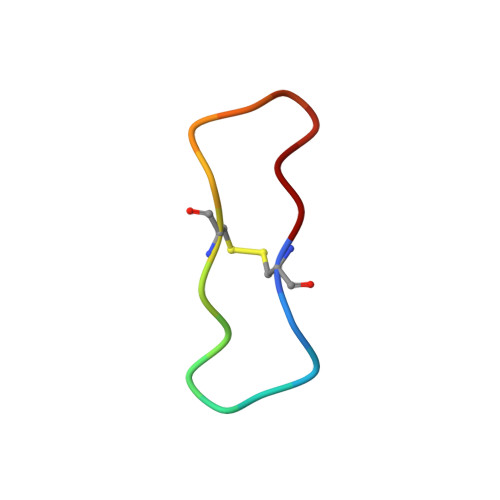Solution Structure of a Novel C2-Symmetrical Bifunctional Bicyclic Inhibitor Based on Sfti-1
Jaulent, A.M., Brauer, A.B.E., Matthews, S.J., Leatherbarrow, R.J.(2005) J Biomol NMR 33: 57
- PubMed: 16222558
- DOI: https://doi.org/10.1007/s10858-005-1210-9
- Primary Citation of Related Structures:
2BEY - PubMed Abstract:
A novel bifunctional bicyclic inhibitor has been created that combines features both from the Bowman-Birk inhibitor (BBI) proteins, which have two distinct inhibitory sites, and from sunflower trypsin inhibitor-1 (SFTI-1), which has a compact bicyclic structure. The inhibitor was designed by fusing together a pair of reactive loops based on a sequence derived from SFTI-1 to create a backbone-cyclized disulfide-bridged 16-mer peptide. This peptide has two symmetrically spaced trypsin binding sites. Its synthesis and biological activity have been reported in a previous communication [Jaulent and Leatherbarrow, 2004, PEDS 17, 681]. In the present study we have examined the three-dimensional structure of the molecule. We find that the new inhibitor, which has a symmetrical 8-mer half-cystine CTKSIPP'I' motif repeated through a C2 symmetry axis also shows a complete symmetry in its three-dimensional structure. Each of the two loops adopts the expected canonical conformation common to all BBIs as well as SFTI-1. We also find that the inhibitor displays a strong and unique structural identity, with a notable lack of minor conformational isomers that characterise most reactive site loop mimics examined to date as well as SFTI-1. This suggests that the presence of the additional cyclic loop acts to restrict conformational mobility and that the deliberate introduction of cyclic symmetry may offer a general route to locking the conformation of beta-hairpin structures.
Organizational Affiliation:
Department of Chemistry, Imperial College London, South Kensington Campus, London, SW7 2AZ, UK.














